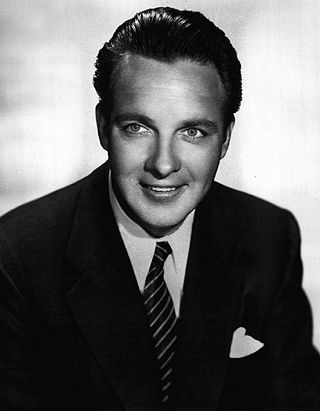
George Robert Crosby was an American jazz singer and bandleader, best known for his group the Bob-Cats, which formed around 1935. The Bob-Cats were a New Orleans Dixieland-style jazz octet. He was the younger brother of famed singer and actor Bing Crosby. On TV, Bob Crosby guest-starred in The Gisele MacKenzie Show. He was also a regular cast member of The Jack Benny Program, on both radio and television, taking over the role of bandleader after Phil Harris' departure. Crosby hosted his own afternoon TV variety show on CBS, The Bob Crosby Show (1953–1957). Crosby received two stars on the Hollywood Walk of Fame, for television and radio.

Tapeheads is a 1988 comedy film directed by Bill Fishman and starring John Cusack, Tim Robbins, Sam Moore and Junior Walker. The film was produced by Michael Nesmith, who briefly appears as a bottled water delivery man.
Drabble is an internationally syndicated comic strip that appears in about 200 newspapers. Kevin Fagan created the strip in 1979 and remains the sole writer and artist. The strip centers on the Drabble family, and is set in a fictionalized version of the greater Los Angeles area.

My Favorite Brunette is a 1947 American romantic comedy film and film noir parody, directed by Elliott Nugent and starring Bob Hope and Dorothy Lamour. Written by Edmund Beloin and Jack Rose, the film is about a baby photographer on death row in San Quentin State Prison who tells reporters his history. While taking care of his private-eye neighbor's office, he is asked by an irresistible baroness to find a missing baron, which initiates a series of confusing but sinister events in a gloomy mansion and a private sanatorium. Spoofing movie detectives and the film noir style, the film features Lon Chaney Jr. playing Willie, a character based on his Of Mice and Men role Lennie; Peter Lorre as Kismet, a comic take on his many film noir roles; and cameo appearances by film noir regular Alan Ladd and Hope partner Bing Crosby. Sequences were filmed in San Francisco and Pebble Beach, California.
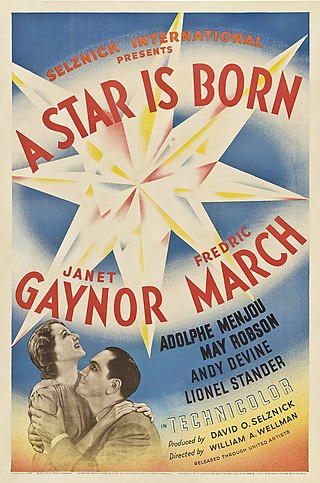
A Star Is Born is a 1937 American Technicolor drama film produced by David O. Selznick, directed by William A. Wellman from a script by Wellman, Robert Carson, Dorothy Parker, and Alan Campbell, and starring Janet Gaynor as an aspiring Hollywood actress, and Fredric March as a fading movie star who helps launch her career. The supporting cast features Adolphe Menjou, May Robson, Andy Devine, Lionel Stander, and Owen Moore.
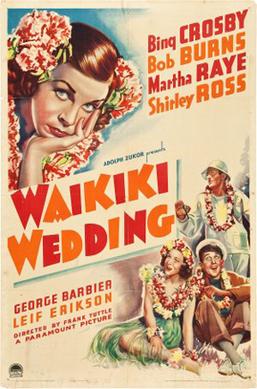
Waikiki Wedding is a 1937 American musical film directed by Frank Tuttle and starring Bing Crosby, Bob Burns, Martha Raye, and Shirley Ross. Crosby plays the part of Tony Marvin, a PR man charged with extolling the virtues of the Territory of Hawaii. The female lead, played by Shirley Ross is a local beauty queen who makes unhelpful comments about the islands. Bob Burns, along with Martha Raye, are the "comic relief". Amongst the supporting cast was a young Anthony Quinn. It was made by Paramount Pictures as a rival to the Fred Astaire and Ginger Rogers films then being made by RKO Pictures.

The Cat and the Canary is a 1922 stage play by John Willard, adapted at least four times into feature films, in 1927, 1930, 1939, and again in 1979. The original stage play opened on Broadway February 7, 1922.

The Cat and the Canary is a 1927 American silent comedy horror film directed by the German Expressionist filmmaker Paul Leni. An adaptation of John Willard's 1922 black-comedy play of the same name, the film stars Laura La Plante as Annabelle West, Forrest Stanley as Charlie Wilder, and Creighton Hale as Paul Jones. The plot revolves around the death of Cyrus West, who is Annabelle, Charlie, and Paul's uncle, and the reading of his will twenty years later. Annabelle inherits her uncle's fortune, but when she and her family spend the night in his haunted mansion, they are stalked by a mysterious figure. Meanwhile, a lunatic mainly known as the Cat escapes from an asylum and hides in the mansion.

The Cat Creeps is a 1930 American pre-Code mystery film directed by Rupert Julian based on the 1922 play The Cat and the Canary by John Willard. The film is a sound remake of The Cat and the Canary (1927). Starring Helen Twelvetrees, Raymond Hackett, Neil Hamilton, Lilyan Tashman, Jean Hersholt, Elizabeth Patterson, and Montagu Love.
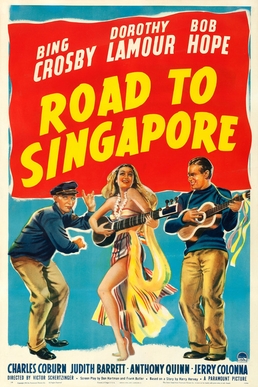
Road to Singapore is a 1940 American semi-musical comedy film directed by Victor Schertzinger and starring Bing Crosby, Dorothy Lamour and Bob Hope. Based on a story by Harry Hervey, the film is about two playboys trying to forget previous romances in British Singapore, where they meet a beautiful woman. Distributed by Paramount Pictures, the film marked the debut of the long-running and popular "Road to ..." series of pictures spotlighting the trio, seven in all. The supporting cast features Charles Coburn, Anthony Quinn, and Jerry Colonna.

The Cat and the Canary is a 1978 horror film directed by Radley Metzger and starring Honor Blackman, Michael Callan, Edward Fox, Wendy Hiller, Olivia Hussey, Wilfred Hyde-White, Beatrix Lehmann, Carol Lynley, Daniel Massey, and Peter McEnery. It follows a group of potential heirs who are summoned to the mansion of a deceased beneficiary to view the filmed reading of his will, only to discover upon arrival that a deranged killer may have infiltrated the event.

Elliott Nugent was an American actor, playwright, writer, and film director.

Bright Lights, later retitled Adventures in Africa, is a 1930 American pre-Code musical comedy film produced and released by First National Pictures, a subsidiary of Warner Bros. It premiered in Los Angeles in July 1930 but was edited and rereleased in early 1931. Although it was photographed entirely in Technicolor, the only surviving print is in black and white. The film stars Dorothy Mackaill, Frank Fay, Noah Beery and Frank McHugh. It also features the screen debut of John Carradine, who appears in a small, uncredited role.

Games is a 1967 American psychological horror film directed by Curtis Harrington, and starring Simone Signoret, James Caan, and Katharine Ross. Its plot follows two jaded Manhattan socialites who engage in a series of mind games with a German cosmetics agent whom they invite into their home.

This is a selection of films and television appearances by British-American comedian and actor Bob Hope (1903-2003). Hope, a former boxer, began his acting career in 1925 in various vaudeville acts and stage performances

Little Lord Fauntleroy is a 1936 American drama film based on the 1886 novel of the same name by Frances Hodgson Burnett. The film stars Freddie Bartholomew, Dolores Costello, and C. Aubrey Smith. The first film produced by David O. Selznick's Selznick International Pictures, it was the studio's most profitable film until Gone with the Wind. The film is directed by John Cromwell.
Rhythm on the Range is a 1936 American Western musical film directed by Norman Taurog and starring Bing Crosby, Frances Farmer, and Bob Burns. Based on a story by Mervin J. Houser, the film is about a cowboy who meets a beautiful young woman while returning from a rodeo in the east, and invites her to stay at his California ranch to experience his simple, honest way of life. Rhythm on the Range was Crosby's only Western film and introduced two western songs, "Empty Saddles" by Billy Hill and "I'm an Old Cowhand " by Johnny Mercer, the latter becoming a national hit song for Crosby. The film played a role in familiarizing its audience with the singing cowboy and Western music on a national level.

Whistling in the Dark is a 1941 comedy film directed by S. Sylvan Simon. It is the first of three films starring Red Skelton as Wally "the Fox" Benton, who writes and acts in radio murder mysteries. Wally is kidnapped by a greedy cult leader, who threatens to kill Wally's girlfriend and another young woman unless he concocts a perfect murder. The film was based on the Broadway play of the same name by Laurence Gross and Edward Childs Carpenter. Uncredited contributing writer Elliott Nugent wrote and directed the earlier film adaptation of the same name.
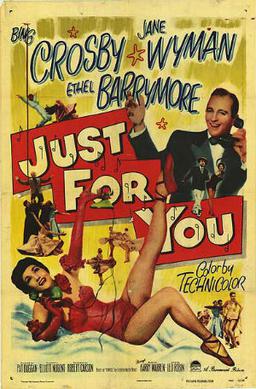
Just for You is a 1952 American musical film starring Bing Crosby and Jane Wyman and the final motion picture to be directed by Elliott Nugent. It was nominated for Best Song at the 1953 Academy Awards. The film was based on the book Famous by Stephen Vincent Benét. Filming took place between October 22 and December 20, 1951. It is said that Judy Garland had originally been sent a script as she was being considered for the female lead, but she apparently decided not to proceed with the project. Location scenes were filmed at Lake Arrowhead, near San Bernardino, California and at Big Bear Lake in the San Bernardino National Forest.
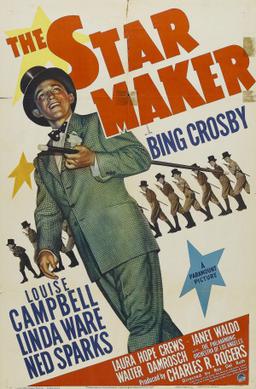
The Star Maker is a 1939 American musical film directed by Roy Del Ruth, written by Frank Butler, Don Hartman and Arthur Caesar, and starring Bing Crosby, Louise Campbell, Linda Ware, Ned Sparks, Laura Hope Crews, Janet Waldo and Walter Damrosch. Filming started in Hollywood on April 17, 1939 and was finished in June. The film was released on August 25, 1939, by Paramount Pictures, and had its New York premiere on August 30, 1939. It was the only film in which Crosby played a happily married man.


















